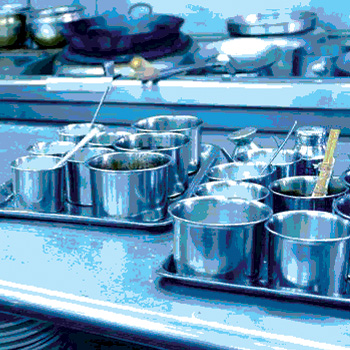Six Tips for Establishing a Safe and Effective Gluten- Free Kitchen

With one in every 100 people living with celiac disease in the U.S., restaurants have been fielding requests from guests for gluten-free options for several years. Front Burner Brands, the management company for fondue restaurant franchise The Melting Pot Restaurants Inc. and affiliated concepts Burger 21 and GrillSmith, heard these requests and took action.
Partnering with the Gluten Intolerance Group (GIG), the research and development team at Front Burner Brands created a gluten-free menu for each restaurant managed by the group, starting with a menu of fondue dishes that are safe for those with gluten intolerance to enjoy at The Melting Pot. While safety and sanitation were top concerns in developing these menus, Front Burner Brands also kept in mind that gluten-intolerant guests want to enjoy tasty dishes too, so if a company is going to provide a gluten-free menu, meals should be delicious as well as safe.
Offering a gluten-free menu can be a valuable service, but before launching the menu, it’s critical to make sure there are procedures in place to ensure that food is prepared safely and the kitchen is sanitized and organized to be able to accommodate gluten-intolerant diners. Following these six steps will help restaurants safely serve gluten-free menu offerings as an added value to guests:
1. Partner with a gluten-free organization for menu creation.
Working with a reputable organization dedicated to raising celiac disease awareness and other forms of gluten intolerance gave Front Burner Brands an edge in establishing its restaurants as providers of safe gluten-free dishes. The GIG analyzed Front Burner Brands’ concepts, menus, products and ingredients by checking labels and nutritional facts to determine items that contained gluten and advised accordingly during the creation of the gluten-free menus. Using their recommendations, Front Burner Brands’ concepts were able to confidently provide guests with gluten-free menu offerings.
Partnering with a gluten-free organi-zation helps take the guesswork out of gluten-free menu creation. These organizations will go ingredient by ingredient within each dish on your menu and help establish which of your current dishes makes sense to offer in gluten-free versions.
The GIG has a number of local branches and partners within most of the continental U.S. (www.gluten.net/local-branches) and would be a great starting point when seeking a reliable partnership. There are a number of gluten-intolerance awareness groups, so review them thoroughly to choose a reputable one.
2. Develop a gluten-free version of your menu.
Once the potential allergy risks on your menu have been determined, start creating a gluten-free menu. To achieve success, it is vital to make sure that your menu includes real, delicious food rather than gluten-free dishes that seem to lack flavor or substance.
If you have eight appetizers on your menu, make one or two gluten-free. If you have 20 entrees, ensure that at least 6 are gluten-free. You want to be able to provide your guests with real offerings, not just a salad without the croutons or a hamburger without the bun. Integrate as many gluten-free foods as you can to stay true to the dish. If you can find an affordable gluten-free substitute, use it. On a national level, Burger 21 partnered with French Meadow Bakery (www.frenchmeadow.com/) to provide gluten-free buns with its gluten-free burgers.
On a local level, it is helpful to explore community partners such as reputable local bakeries to provide gluten-free breads, desserts and more. Many Melting Pot locations partner with local gluten-free bakeries to provide additional fondue dippers like gluten-free bread, brownies and pound cake. In many cases, guests suggested these bakeries to local restaurant owners, so guest surveys are key to earning buy-in.
While creating gluten-free offerings may not be a key goal when coming up with new menu items, it should be considered. You should always take into account whether gluten-free diners can enjoy a dish. If yes, great! If not, think about what small adjustments could be made to maintain the flavor profile and include these on the gluten-free menu. If you can make some subtle changes to the recipe to accommodate gluten-free dietary restrictions, then do it. Your guests will appreciate the extra effort.
However, if changing too many ingredients changes the flavor profile or increases food costs too much, then it does not make sense to put that dish on your menu.
3. Identify gluten-containing ingredients in your kitchen and isolate them.
Dedicate a section on your line only to gluten-free food preparation. That way, your line cooks can prepare gluten-free items without worrying about cross-contamination.
It is also important to separate items in your storage and walk-ins to make sure there is no cross-contamination. Usually, produce and most items in your walk-in do not contain gluten, but many dry goods have gluten, so you’ll need to look closely at your dry storage and separate items to protect against cross-contamination.
After working with the GIG, The Melting Pot decided to minimize risk to gluten-free diners by completely eliminating flour from the kitchen shortly after the gluten-free menu launched. All of The Melting Pot’s cheese fondues are now made using cornstarch, which is gluten-free, instead of wheat flour, as before. Making this tweak to all cheese fondue recipes didn’t impact the flavor profile of the dishes while creating a safer environment for food preparation.
4. Dedicate equipment to be used for gluten-free menu items and keep the kitchen sanitized at all times.
During food preparation, separation and cleanliness are key. It is important to keep the kitchen spotless, and always put on new, clean foodservice gloves over clean hands before handling gluten-free foods, no matter the job function in the restaurant. At Burger 21, managers place a handful of gloves on a gluten-free tray to make it easy for everyone to change gloves when preparing the food down the line.
It is vital to ensure that everyone on the line is aware that an order needs to be made gluten-free. At Burger 21, gluten-free stickers are used to let guests know that staff members are educated about gluten intolerance and took extra steps when preparing those meals.
In addition to having gloves con-venient, dedicated equipment for preparing only gluten-free foods is crucial. Make sure to have fryers and equipment (ovens, warmers, etc.) labeled for gluten-free cooking only.
A gluten-free kit including sanitized tongs, spatulas, grill brushes, sauté pans, a cutting board, etc. is also an easy way to make sure that sanitized tools are ready for use when a guest orders a gluten-free menu item. It takes very little time to put together a kit, so when a gluten-free order comes down the line, staff can grab a kit to make preparation a breeze. Sanitize the kits after each use.
At Burger 21 and GrillSmith restaurants, staff use green-handled cooking and prep utensils for all gluten-free orders. Employees also make sure that gluten-free orders are brought to tables on separate trays with no other orders placed on those trays.
The key to ensuring the kitchen is always properly sanitized is keeping it clean overall and at all times. Cleaning multiple times throughout each day and making sure all equipment is sanitized after each use will make the process flow smoothly. The biggest challenges will be monitoring staff and checking that they consistently follow safety procedures.
5. Educate and train staff.
After sanitation procedures have been ironed out, training staff on the dangers of gluten contamination and what they need to do while preparing gluten-free offerings is paramount. Providing proper gluten-free training materials is a great way to gain support. Get staff to buy into the program. If they don’t share your passion, it will be difficult to implement a successful gluten-free menu.
At Burger 21, for example, the Front Burner Brands training team trained all managers on gluten, gluten sensitivity and celiac disease, and these managers then conducted training with all Burger 21 team members. All new team members going forward receive the same training. The company also assigns a manager or key team member to oversee any gluten-free orders all the way down the line and trains new team members as necessary during each shift.
Knowledge is everything. Often, people don’t know where food comes from or how it is prepared. Simple, incorrect statements meant to be helpful can quickly show how little a team member really knows and erode guest confidence. Provide staff with charts that spell out which items are never gluten-free and which can be made gluten-free with adjustments.
Training materials that stress team member responsibilities during gluten-free food preparation will prove helpful for both the guest and team members. By providing proper materials to staff, you increase awareness and good service, resulting in grateful patrons.
6. Gather feedback from guests.
Once you have launched new gluten-free items, it is a good idea to step out of the kitchen and into the dining room to interact with guests trying the dishes. It feels good to know that guests are happy and enjoying dishes your team carefully prepared, and it is helpful to reiterate that they can safely enjoy meals outside their homes.
For years, many guests with gluten intolerance have not been able to dine at a restaurant, either because they didn’t trust the food would be prepared safely or they didn’t know gluten-free options were available. As more restaurants take measures to provide gluten-free offerings, guests are now finally able to have a complete gluten-free restaurant meal, so talk to them about their experiences. Get their unedited feedback. Customers love to share their opinions, especially with the chef or manager, so this should be an easy way to gain customer feedback on the menu.
Guest responses at The Melting Pot and Burger 21 have been fantastic. These restaurants serve many gluten-intolerant guests who have been elated to find out that one of their favorite restaurants has taken the initiative to develop a menu that addresses their needs. In many cases, the attention paid by restaurants to gluten-free guests’ safety and enjoyment translates into loyalty for years to come.
You don’t have to go to extremes in altering your kitchen to provide safe gluten-free orders for these guests, but be aware of what needs to be done to ensure the safety of your gluten-free offerings. If costs are a concern, you can increase prices slightly to account for the extra costs associated with creating and maintaining a gluten-free menu. Front Burner Brands’ restaurant concepts do not charge extra for gluten-free offerings, but if this additional cost is necessary, guests will understand.
With a few tweaks to your kitchen and careful attention to sanitation and staff training, you can run a successful gluten-free kitchen within your current setup. Seeing consumers’ joy as they bite into delicious gluten-free dishes without fear will make the extra effort worthwhile.
 Shane Schaibly is corporate chef for Front Burner Brands Inc., a full-service and fast-casual restaurant management company headquartered in Tampa, FL, and affiliated with dynamic and niche-specific brands such as The Melting Pot fondue franchise, the Burger 21 franchise and GrillSmith restaurants.
Shane Schaibly is corporate chef for Front Burner Brands Inc., a full-service and fast-casual restaurant management company headquartered in Tampa, FL, and affiliated with dynamic and niche-specific brands such as The Melting Pot fondue franchise, the Burger 21 franchise and GrillSmith restaurants.
p>
Looking for a reprint of this article?
From high-res PDFs to custom plaques, order your copy today!








